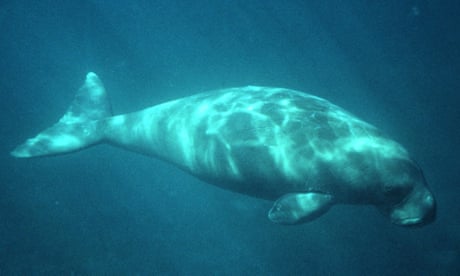Extract from The Guardian
Marine park’s chief scientist says aerial surveys so far indicate bleaching worst off Townsville.
Fri 18 Mar 2022 16.39 AEDT
Leading reef scientist Prof Terry Hughes said this week a sixth mass bleaching event was now unfolding on the reef, adding to events in 1998, 2002, 2016, 2017 and 2020.
“We want to finish the aerial surveys to really understand this before we make a call on the extent and severity of this bleaching.”
Lobbying last year by the Morrison government saw the 21-country world heritage committee go against UN advice to put the reef on a list of sites in danger. The committee will consider the reef again at a meeting in June, armed with a report from the UN visit.
Aerial surveys from helicopters that started last Saturday have revealed mild to moderate bleaching driven by rising ocean temperatures on reefs in the remote far north, with the most badly hit reefs across a 250km stretch to the north and south of Townsville.
Most reefs in that central region, between Hinchinbrook Island and Bowen, were severely bleached and there were still reefs not yet surveyed there.
Bleaching is considered minor if less than 10% of corals on an individual reef are bleached. Levels up to 30% are categorised as moderate, up to 60% is major and beyond that, bleaching is considered severe.
“We certainly have widespread bleaching. It’s variable,” Wachenfeld said.
“The fact that at the very least, from Hinchinbrook to Bowen, most reefs are severely bleached – this is a very serious event. There is no question about that. Some of the observations in that region have been of coral mortality.
“That is where the heat stress has been worst. We haven’t yet surveyed all that area, but I would expect that situation of most reefs being severely bleached would go north and south of Bowen.”
Aerial surveys started while the heat stress was still building across large parts of the reef. Wachenfeld said rather than wait until the heat had peaked, the flights had started because “we are starting to see coral die.”
When a coral bleaches, the transparent flesh and white skeleton are easy to see from the air. But if it dies, the flesh begins to rot and is quickly taken over by algae which is darker in colour.
“You then can’t see from the air that a living coral was there a week ago,” said Wachenfeld.
Flights are expected to continue until the end of next week. Planes will be used to survey outer reefs in the south.
Surveys have not yet been conducted over the major tourism areas around Cairns and Port Douglas, but heat stress has been lower in those areas.
In the remote north, Wachenfeld said some reefs had not recovered from a severe 2016 bleaching event. Reports of “no bleaching” from this week’s flights were down to there being little live coral left.
Dr Britta Schaffelke, director of Great Barrier Reef research at the Australian Institute of Marine Science – a partner in the survey effort – told Guardian Australia it was too early to know how the current event compared to previous ones.
“At the moment, what we see is widespread and in some parts it is severe and that is worrying. There is no doubt about it,” she said.
While some bleached corals can recover, those badly hit can take weeks or months to die from bleaching, so the full impact of the current event will take a long time to fully understand.
“It’s a major stress event for corals even if they don’t die from it. There is no historical record of such stress events happening so frequently,” Schaffelke said.
Richard Leck, head of oceans at WWF Australia, said bleaching was directly attributable to global heating caused by rising greenhouse gas emissions.
“Reducing Australia’s domestic and exported emissions fast, this decade, is the main solution within our control,” he said.
The environment group released analysis on Friday showing that for Australia to be part of efforts to keep global heating to 1.5C, the country should release no more than 4bn tonnes of CO2 between now and mid-century.
But the analysis, carried out by scientists, said the Morrison government’s current strategy to reach net zero would release 9.6bn tonnes.
“We’re going to blow our emissions budget by more than double,” said Leck.
Dr Zebedee Nicholls, one of the scientists that carried out the analysis, said: “The science is clear: the outlook for coral reefs around the world is bad at 1.5C, and their fate is all but sealed at 2C.”
Greenpeace Australia climate impacts campaigner Martin Zavan said: “This latest bleaching event has once again exposed the Morrison government’s failure to protect the Great Barrier Reef, throwing billions at band-aid measures while failing to address climate change, the biggest driver of catastrophic coral damage.”
Kelly O’Shanassy, chief executive of the Australian Conservation Foundation, said: “If the federal government is serious about its claim of wanting to protect the Great Barrier Reef it must rapidly phase out coal, oil and gas and stop encouraging the growth of fossil fuel industries.”
Dr Lissa Schindler, reef campaigner at the Australian Marine Conservation Society, said the unfolding bleaching was “disastrous news” for the marine and communities that relied on the reef.
“What is most concerning is that this widespread bleaching is happening during a La Niña weather event, which is normally characterised by rain and cloud cover on the east coast of Australia often helping to cool waters. It shows the consistent pressure our reef is now under from global heating.”
Guardian Australia has approached the environment minister, Sussan Ley, for comment about the bleaching.

No comments:
Post a Comment